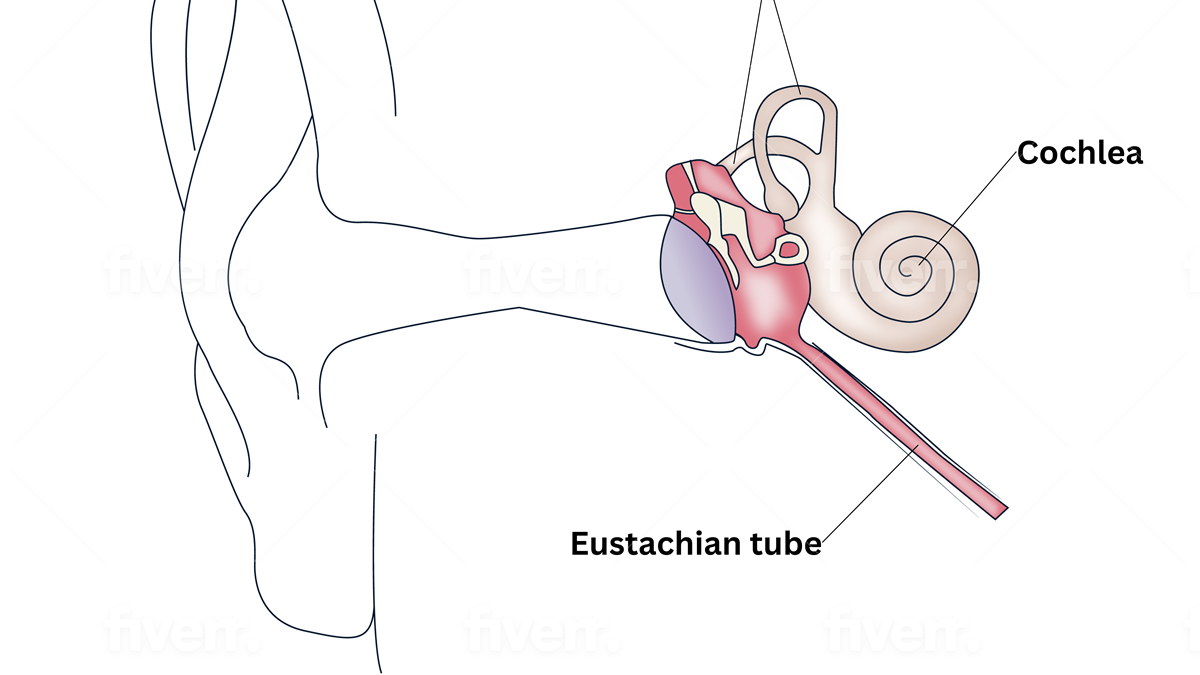The Ears
The structure of the ear
The outer, visible ear helps to channel sounds into the ear canal. The sound waves travel down the canal into the middle ear where they hit the eardrum, making it vibrate. Three tiny bones, the malleus, incus, and stapes, then amplify the vibrations.
The vibrations then travel to the cochlea, a snail-shaped organ in the inner ear that is filled with fluid. The vibrations send ripples through the fluid, which are sensed by thousands of hair cells within the cochlea. The hair cells than convert the vibrations into electrical signals, which are sent to the brain through the auditory nerve.
The brain then interprets these signals as recognisable sounds, from an approaching car to speech. It also locates which direction the sound is coming from.
Effects of radiotherapy on hearing
Some treatments for salivary gland cancers can affect your hearing, in particular, radiotherapy that is directed at the head and neck area. Hearing difficulties can occur during radiotherapy or as a late-onset side effect some months or even years after treatment. In many cases where some hearing loss occurs, symptoms begin to develop in the first two years after treatment ends.
Not everyone who has radiotherapy in the head or neck will experience problems with their hearing. The dose and type of radiation therapy used, as well as the location of the tumour site are all factors that affect how likely it is that hearing loss develops.
Hearing loss experienced during or after radiotherapy can be temporary or permanent. When it is caused by swelling, infection or blockage in the inner or middle ear it can often be partially or completely reversed. However, when the auditory nerve or hair cells of the inner ear are damaged by radiation, a degree of permanent hearing loss can develop – although treatment options are still available to help with this.
There are two main types of hearing loss that can occur after radiotherapy for salivary gland cancers:
-
Conductive hearing loss
Head and neck radiotherapy increases the likelihood of developing middle ear infections (or Otitis Media) which can cause swelling, pain and discharge from the ear. This can be treated with pain killers if mild, and antibiotics or anti-inflammatories if more severe.
Some patients also experience Eustachian Tube dysfunction. The Eustachian tube is a canal that connects the middle ear to the throat and helps to equalise air pressure in the ear. It also drains fluid from the middle ear. Radiation can cause swelling, inflammation, and tissue fibrosis in the Eustachian tube lining, affecting its ability to open and close properly. This causes fluids to build up in the middle ear. Symptoms can include muffled hearing, and a sense of pressure in the ear. It can initially be treated with decongestants and nasal steroids, but in some cases a simple operation is necessary to remove the blockage.
-
Sensorineural hearing loss
Radiotherapy can also damage the delicate structures of the inner ear, including the cochlea and the auditory nerve, which can lead to more permanent hearing issues. The radiation and its after-effects can directly destroy the hair cells and the blood vessels that supply them. Such sensorineural hearing loss (SNHL) often develops gradually, months or even years after the end of radiotherapy treatment.
That’s why it’s important to monitor your hearing levels after treatment and have regular hearing tests. Early warning signs include difficulty hearing high-pitched sounds, or understanding speech in noisy, crowded environments. There are a range of treatments, from small, discrete digital hearing aids to cochlea implants, depending on the severity of the problem. Cochlea implants bypass damaged areas of the ear and use electronic impulses to directly stimulate the auditory nerve. An operation is necessary to insert one.
If you are experiencing any hearing problems after radiotherapy, tell your cancer nurse or doctor and they can arrange for you to see a specialist. You may be referred to an audiologist, or an ENT (ear, nose and throat) doctor.
Tinnitus
Tinnitus can be a side effect of radiotherapy in the head and neck area which some patients with salivary gland cancer experience. It’s a condition where you hear sounds that are coming from inside your body, rather than from an outside source.
The noises can sound like ringing, whistling, roaring, buzzing or hissing. For some people, the sounds come and go. For others, they are constant. There is also a rarer form of the condition called musical tinnitus, where you can hear music when none is being played.
Tinnitus is much more noticeable in quiet environments, so some people find having background noise like a radio or a ticking clock helps reduce the invasiveness of their experience. Meditation, exercise and relaxation techniques can also help, as anxiety can make the condition worse.
For more information, advice and support, contact Tinnitus.uk.
Last updated June 2025

